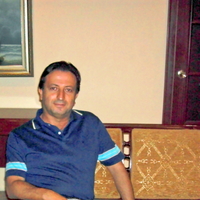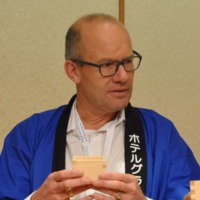Papers by Carlos Lucasius
Journal of Crystal Growth, 1989
Abstract Surface patterns of growth spirals on the (010) face of potassium hydrogen phthalate (KA... more Abstract Surface patterns of growth spirals on the (010) face of potassium hydrogen phthalate (KAP) were studied in situ using optical reflection microscopy. Besides the normal morphology of this spiral, which was discussed before, a number of irregularities have been observed whose appearance are explained on the basis of the internal crystal structure using a two-dimensional PBC-like analysis. Detailed observations of specific changes in spiral phenomena after the addition of a number of different impurities have resulted in direct information about the adsorption site of these impurities on the crystal surface.
Chemometrics and Intelligent Laboratory Systems, 1990

Journal of Crystal Growth, 1988
Quantitative information about the influence of impurities on the crystal growth process of potas... more Quantitative information about the influence of impurities on the crystal growth process of potassium hydrogen phthalate from its aqueous solution was obtained at two levels: microscopic and macroscopic. At the microscopic level, detailed in situ observations of spiral steps at the (010) face were performed. The velocity of these steps was measured, as well in a "clean" as in a contaminated solution, where the influence of a number of different impurities was mvestigated. This resulted in a measure of effectiveness of step retardation for each of these impurities. From the same microscopic observations it was observed how these effectiveness factors were influenced by the supersaturation c~, the saturation temperature 7~of the solution and the concentration c,mp of the impurity that was used. At the macroscopic level, ICP (inductively coupled plasma) measurements were carried out in order to determine the distribution coefficient of the same impurities. In these measurements again the influence of the impurity concentration and the supersaturation on the distribution coefficient k 0 was determined.
Chemometrics and Intelligent Laboratory Systems, 1993
Chemometrics and Intelligent Laboratory Systems, 1994
Lecture Notes in Computer Science, 1991
Among techniques for conformational analysis of DNA molecules, restrained molecular dynamics and ... more Among techniques for conformational analysis of DNA molecules, restrained molecular dynamics and distance geometry are, up to now, most widely used. Both techniques are essentially based on local search strategies which use evaluation criteria that are simplified for pragmatic reasons. In practice, this approach appears to be decreasingly adequate when increasingly complex conformational spaces are dealt with.
Analytica Chimica Acta, 1993
An automatic system for the interpretation of two-dimensional NMR spectra of proteins, HIPS, is p... more An automatic system for the interpretation of two-dimensional NMR spectra of proteins, HIPS, is presented. Several artificial intelligence techniques are combined to form a flexible, hybrid system that has (limited) learning capabilities. Following the structure of the problem, the system is divided in modules with distinct functionalities. The first two modules are rule-based, and can be validated and refined semi-automatically using a set of already interpreted spectra. In this way, an optimized ruleset can be obtained to interpret unknown spectra. Results indicate a significant effect of training on performance. In the third module, a genetic algorithm is used to tackle a search problem of huge dimensions in which patterns found in the NMR spectra should be mapped to amino acids in the sequence.
Information and Software Technology, 1994
The focus of this paper is database design using automated database design tools or more general ... more The focus of this paper is database design using automated database design tools or more general CASE tools. We present a genetic algorithm for the optimization of (internal) database structures, using a multi-criterion objective function. This function expresses conflicting objectives, reflecting the well-known time/space trade-off. This paper shows how the solution space of the algorithm can be set up in the form of tree structures (forests), and how these are encoded by a simple integer assignation. Genetic operators (database transformations) defined in terms of this encoding behave as if they manipulate tree structures. Some basic experimental results produced by a research prototype are presented.
Journal of Chemical Information and Modeling, 1993
This paper describes several new results of the project C2I at the University of Nijmegen,The Net... more This paper describes several new results of the project C2I at the University of Nijmegen,The Netherlands. The focus of C2I is the transformation of data models from the conceptual to the internal level. Several aspects are involved, such as data structures, operations,populations (values) and integrity constraints. Special emphasis is given to optimization ofdata structures with respect to the trade-off between response time and storage space.New results include PHSL, an abstract Pool...
Analytica Chimica Acta, Feb 1, 1994
This paper presents a comparative study involving a genetic algorithm, simulated annealing, and s... more This paper presents a comparative study involving a genetic algorithm, simulated annealing, and stepwise elimination, as methods for wavelength selection in multi-component analysis. The wavelength selection criteria used are the selectivity and accuracy after Lorber, and the minimal mean squared error after Sasaki. The genetic algorithm generally performed best. Stepwise elimination performed surprisingly good despite its local search heuristic. Simulated annealing performed worst, which is remarkable in view of the fact that this method is widely praised in the literature for properties similar to those of genetic algorithms, e.g., a probabilistic, non-local search heuristic.
Chemometrics and Intelligent Laboratory …, Jan 1, 1993
Lucasius, C.B. and Kateman, G., 1993. Understanding and using genetic algorithms. Part 1. Concept... more Lucasius, C.B. and Kateman, G., 1993. Understanding and using genetic algorithms. Part 1. Concepts, properties and contexts.
Chemometrics and Intelligent Laboratory …, Jan 1, 1994
Lucasius, C.B. and Kateman, G., 1993. Understanding and using genetic algorithms. Part 1. Concept... more Lucasius, C.B. and Kateman, G., 1993. Understanding and using genetic algorithms. Part 1. Concepts, properties and contexts.
Analytica Chimica Acta, Jan 1, 1994
This paper presents a comparative study involving a genetic algorithm, simulated annealing, and s... more This paper presents a comparative study involving a genetic algorithm, simulated annealing, and stepwise elimination, as methods for wavelength selection in multi-component analysis. The wavelength selection criteria used are the selectivity and accuracy after Lorber, and the minimal mean squared error after Sasaki. The genetic algorithm generally performed best. Stepwise elimination performed surprisingly good despite its local search heuristic. Simulated annealing performed worst, which is remarkable in view of the fact that this method is widely praised in the literature for properties similar to those of genetic algorithms, e.g., a probabilistic, non-local search heuristic.

Analytica Chimica Acta, Jan 1, 1992
The target vector cntenon as the vector distance between a set of desned responses and a set of r... more The target vector cntenon as the vector distance between a set of desned responses and a set of really obtained responses of a multrvanate function was combined with the genetic algonthm to Improve simultaneously SIX properties of a biochemical test stnp for human blood glucose detennmatlon as a function of twelve chenucal and technological parameters The advantage of the genetic algonthm m comparison with other search techniques became obwous for the search m this twelve-dnnenslonal vanables space Hrlth up to seven bit resolution, 1 e , up to 193= search positions The results obtamed by target vector optlmlzatlon on the basis of the genetlc search technique were cntlcally compared urlth the results obtained by a prediction with classical and non-hnear partlal least-squares regression and reahzed m laboratory and industrial venficatlon expe.nments In this way advantages and disadvantages of deductive and mductlve polyoptrmlzatlon strategies could be discussed theoretically and with respect to expenmental results Multlcrlterlal or polyoptnmzatlon means the simultaneous search of the desired values y(d) = 1 Y l(d), Y,(d),
TrAC Trends in Analytical Chemistry, Jan 1, 1991
The genetic algorithm is proposed as a powerful search strategy for chemometricians engaged in la... more The genetic algorithm is proposed as a powerful search strategy for chemometricians engaged in large-scale optimization problems. The search space is explored while past information is exploited using memory gleaned from a natural evolution process. The algorithm is robust ...

Analytica Chimica Acta, Jan 1, 1992
Genetlc algorithms constitute a set of powerful search heunstlcs A mod&led genetic algonthm was u... more Genetlc algorithms constitute a set of powerful search heunstlcs A mod&led genetic algonthm was used to optunlze cahbratlon data sets In order to construct an Ideal genetic procedure, the dwerslty m a population IS cruaal The Idea proposed 1s to e&mate the dlverslhes along two dtrectlons, namely the dlverslty between the chromosomes m a population and the dlverslty between the alleles m all chromosomes The newly defined dwerslty functions are able to descnbe the procedure of a genetlc algonthm m detad and can be used as a feedback for dynanuc control of the process m an almost Ideal way The optlrmzatlon results show that for both short and long runs the dynamic genetic algorithm IS supermr to the "classsal" genetlc algonthms and that after optlrmzatlon not only can the data sets be compacted and refined but also the predlctlve abdlty of the calibration model can be unproved Keywom!s Optmuzatlon methods, Cahbratlon, Dynanuc control, Gene& algorithms, Wavelength selection Correspondence to Tong-Hua LI, Department of Chemistry, Tongs Umverslty, Shanglxu 2000!92 (Chma)

Analytica Chimica Acta, Jan 1, 1993
A novel approach to the problem of k-medoid clustering of large data sets is presented, using a g... more A novel approach to the problem of k-medoid clustering of large data sets is presented, using a genetic algorithm. Genetic algorithms comprise a family of optimization methods based loosely upon principles of natural evolution. They have proven to be especially suited to tackle complex, large-scale optimization problems efficiently, including a rapidly growing variety of problems of practical utility. Our pilot study lays emphasis on the feasibility of GCA -our genetic algorithm for k-medoid clustering of large datasets -and provides some background information to elucidate differences with traditional approaches. The experimental part of this study is done on the basis of artificial data sets and includes a comparison with CLARA -another approach to k-medoid clustering of large data sets, introduced recently. Results indicate that GCA accomplishes a better sampling of the combinatorial search space.









Uploads
Papers by Carlos Lucasius